Multivariate Analysis of Attitudes, Knowledge and Use of ICT in Students Involved in Virtual Research Seedbeds
Abstract
1. Introduction
1.1. Contextualisation of the Use of Information and Communication Technologies (ICTs) in Virtual Mode Programmes in Colombia
1.2. Attitudes, Knowledge and Uses of ICTs
2. Materials and Methods
3. Results
4. Discussion
5. Conclusions
Author Contributions
Funding
Institutional Review Board Statement
Informed Consent Statement
Data Availability Statement
Conflicts of Interest
References
- Ministerio de Educación Nacional de la Republica de Colombia. Decreto 1330 del 2019. Available online: https://www.mineducacion.gov.co/1759/w3-article-387348.html?_noredirect=1 (accessed on 11 November 2020).
- Martínez, M.A. Semillero de investigación en modalidad virtual: Diseño, implementación y gestión, caso de estudio. In Diálogo de Ciencias Sociales, Económicas y Administrativas: Perspectivas Tendencias y Retos, 1st ed.; Guzmán, A., Maerín-Caro, E., Eds.; Corporación Universitaria de Asturias: Bogotá, Colombia, 2020; pp. 46–55. [Google Scholar]
- Corpas-Iguarán, E.J. Virtualización de los semilleros de investigación: Acaso un modelo de continuidad. Rev. Cienc. Salud 2010, 8, 77–87. [Google Scholar]
- Díaz-López, L.M.; Ruiz-Claros, C.; Cuellar-Cuellar, K.Y. Diseño de estrategias para incentivar la participación de los estudiantes del programa Administración de Empresas en los semilleros de investigación de la Universidad de la Amazonía. Rev. Esc. Adm. Neg. 2019, 227–244. [Google Scholar] [CrossRef]
- Martínez-Bravo, M.C.; Sádaba, C.; Serrano-Puche, J. Desarrollo de competencias digitales en comunidades virtuales: Un análisis de “scolartic”. Prism. Soc. 2018, 20, 129–159. [Google Scholar]
- Martínez, M.A. Aprendizaje y retos para la apropiación e implementación de la investigación en programas de educación virtual: Caso fundación universitaria del área andina. In Innovación Docente e Investigación en Ciencias, Ingeniería y Arquitectura, 1st ed.; Gázquez, J.J., Ed.; Dykinson: Madrid, Spain, 2019; pp. 257–269. [Google Scholar]
- Pelgrum, W.J. Obstacles to the integration of ICT in education: Results from a worldwide educational assessment. Comput. Educ. 2001, 37, 163–178. [Google Scholar] [CrossRef]
- Nabeel, A.; Shahrir, J.; Chin Hai, L. Measuring Attitudes toward Computer and Internet Usage among Postgraduate Students in Malaysia. Turk. Online J. Educ. Technol. 2013, 12, 200–216. [Google Scholar]
- Edmunds, R.; Thorpe, M.; Conole, G. Student attitudes towards and use of ICT in course study, work and social activity: A technology acceptance model approach: Exploring student perceptions of ICT in three contexts. Br. J. Educ. Technol. 2012, 43, 71–84. [Google Scholar] [CrossRef]
- Vroman, K.G.; Arthanat, S.; Lysack, C. “Who over 65 is online?” Older adults’ dispositions toward information communication technology. Comput. Hum. Behav. 2015, 43, 156–166. [Google Scholar] [CrossRef]
- Sánchez, J.; Salinas, A.; Contreras, D.; Meyer, E. Does the New Digital Generation of Learners Exist? A Qualitative Study. Br. J. Educ. Technol. 2011, 42, 543–556. [Google Scholar] [CrossRef]
- Selwyn, N. The use of computer technology in university teaching and learning: A critical perspective. J. Comput. Assist. Learn 2007, 23, 83–94. [Google Scholar] [CrossRef]
- López-Pérez, M.V.; Pérez-López, M.C.; Rodríguez-Ariza, L. Blended learning in higher education: Students’ perceptions and their relation to outcomes. Comput. Educ. 2011, 56, 818–826. [Google Scholar] [CrossRef]
- Benson, S.N.K.; Ward, C.L. Teaching with Technology: Using Tpack to Understand Teaching Expertise in Online Higher Education. J. Educ. Comput. Res. 2013, 48, 153–172. [Google Scholar] [CrossRef]
- Tømte, C.; Enochsson, A.; Buskqvist, U.; Kårstein, A. Educating online student teachers to master professional digital competence: The TPACK-framework goes online. Comput. Educ. 2015, 84, 26–35. [Google Scholar] [CrossRef]
- Amhag, L.; Hellström, L.; Stigmar, M. Teacher Educators’ Use of Digital Tools and Needs for Digital Competence in Higher Education. J. Digit. Learn. Teach. Educ. 2019, 35, 203–220. [Google Scholar] [CrossRef]
- Waycott, J.; Bennett, S.; Kennedy, G.; Dalgarno, B.; Gray, K. Digital divides? Student and staff perceptions of information and communication technologies. Comput. Educ. 2010, 54, 1202–1211. [Google Scholar] [CrossRef]
- Slechtova, P. Attitudes of Undergraduate Students to the Use of ICT in Education. Procedia Soc. Behav. Sci. 2015, 171, 1128–1134. [Google Scholar] [CrossRef]
- Acosta-Núñez, J.N.; Parrales-Poveda, M.L.; Arcos-Coba, A.P. Aplicación de las herramientas TICs en el proceso enseñanza-aprendizaje. Dominio De Las Cienc. 2017, 3, 827–840. [Google Scholar]
- Criollo, M.; Romero, M.; Fontaines-Ruiz, T. Autoeficacia para el aprendizaje de la investigación en estudiantes universitarios. Psicol. Educ. 2017, 23, 63–72. [Google Scholar] [CrossRef]
- Pozo, M.A.; Cruz, M.A. Contenido científico en la formación investigativa a través de las TIC en estudiantes universitarios. e-Cienc. De La Inf. 2020, 10. [Google Scholar] [CrossRef]
- Ministerio de Tecnologías de la Información y Comunicación. Boletín trimestral de las TIC. 2020. Available online: https://colombiatic.mintic.gov.co/679/articles-125648_archivo_pdf.pdf (accessed on 18 December 2020).
- Levano-Francia, L.; Sanchez, S.; Guillén-Aparicio, P.; Tello-Cabello, S.; Herrera-Paico, N.; Collantes-Inga, Z. Digital Competences and Education. Propósitos Represent. 2019, 7, 569–588. [Google Scholar] [CrossRef]
- Cheung, D. Developing a Scale to Measure Students’ Attitudes toward Chemistry Lessons. Int. J. Sci. Educ. 2009, 31, 2185–2203. [Google Scholar] [CrossRef]
- Guitart-Aced, R. Las Actitudes en el Centro Escolar; Graó: Barcelona, Spain, 2002; Volume 171. [Google Scholar]
- Huskinson, T.L.H.; Haddock, G. Individual differences in attitude structure: Variance in the chronic reliance on affective and cognitive information. J. Exp. Soc. Psychol. 2004, 40, 82–90. [Google Scholar] [CrossRef]
- Maio, G.; Haddock, G. Theories of Attitude; Maio, R., Ed.; Contemporary Perspectives on the Psychology of Attitudes; Psychology Press: New York, NY, USA, 2004; pp. 424–446. [Google Scholar]
- Casillas, S.; Cabezas, M.; García, F.J. Digital competence of early childhood education teachers: Attitude, knowledge and use of ICT. Eur. J. Teach. Educ. 2020, 43, 210–223. [Google Scholar] [CrossRef]
- Chiao, C.; Chiu, C.-H. The Mediating Effect of ICT Usage on the Relationship between Students’ Socioeconomic Status and Achievement. Asia-Pac. Edu. Res. 2018, 27, 109–121. [Google Scholar] [CrossRef]
- Knezek, G.; Christensen, R. The Importance of Information Technology Attitudes and Competencies in Primary and Secondary Education. In International Handbook of Information Technology in Primary and Secondary Education, 1st ed.; Voogt, J., Knezek, G., Eds.; Springer US: Boston, MA, USA, 2008; Volume 20, pp. 321–331. [Google Scholar]
- Herrador-Alcaide, T.C.; Hernández-Solís, M. Educación Digital Contable mediante Redes de Innovación: Una Medición de su Impacto. Digit. Educ. Rev. 2016, 29, 247–264. [Google Scholar] [CrossRef]
- Chen, C.-L.; Wu, C.-C. Students’ Behavioral Intention to Use and Achievements in ICT-Integrated Mathematics Remedial Instruction: Case Study of a Calculus Course. Comput. Educ. 2020, 145, 103740. [Google Scholar] [CrossRef]
- Alsadoon, H. Students’ perceptions of E-assessment at Saudi Electronic University. Turk. Online J. Educ. Technol. 2017, 16, 147–153. [Google Scholar]
- Silva, R.; Rodrigues, R.; Leal, C. Play it again: How game-based learning improves flow in Accounting and Marketing education. Account. Eduation. 2019, 28, 484–507. [Google Scholar] [CrossRef]
- Van Wyk, M.M. Exploring student teachers’ views on e-portfolios as an empowering tool to enhance self-directed learning in an online teacher education course. Aust. J. Teach. Educ. 2017, 42, 1–21. [Google Scholar] [CrossRef]
- De la Fuente Sánchez, D.; Solís, M.H.; Martos, I.P. El mini video como recurso didáctico en el aprendizaje de materias cuantitativas. RIED 2013, 16, 177–192. [Google Scholar] [CrossRef]
- Johnston, J.; Killion, J.; Oomen, J. Student satisfaction in the virtual classroom. Internet J. Allied Health Sci. Pract. 2005, 3, 6. [Google Scholar]
- Brecht, H.D.; Ogilby, S.M. Enabling a comprehensive teaching strategy: Video lectures. J. Inf. Technol. Educ. 2008, 7, 71–86. [Google Scholar]
- Brush, T.; Glazewski, K.D.; Hew, K.F. Development of an Instrument to Measure Preservice Teachers’ Technology Skills, Technology Beliefs, and Technology Barriers. Comput. Sch. 2008, 25, 112–125. [Google Scholar] [CrossRef]
- Castro, J.J.; Alemán, C.E. Teachers’ opinion survey on the use of ICT tools to support attendance-based teaching. Comput. Educ. 2011, 56, 911–915. [Google Scholar] [CrossRef]
- Ching, C.; Joyce, L.K.; Chin-Chung, T. Facilitating Preservice Teachers’ Development of Technological, Pedagogical, and Content Knowledge (TPACK). Educ. Technol. Soc. 2010, 13, 63–73. [Google Scholar]
- Vega, M.E.; Morales, D.; Graverán, B.A. Knowledge of the harmful effects of ICT of students of the Latin American School of Medicine. Cuba Salud 2020, 15, 6–10. [Google Scholar]
- Rajabion, L.; Wakil, K.; Badfar, A.; Naeini, S.M.; Zareie, B. A New Model for Assessing the Impact of ICT and Digital Knowledge on Students’ Thoughts and Beliefs. J. Eng. Des. Technol. 2019, 17, 943–959. [Google Scholar] [CrossRef]
- Levin, T.; Wadmany, R. Teachers’ Beliefs and Practices in Technology-based Classrooms. J. Res. Technol. Educ. 2006, 39, 157–181. [Google Scholar] [CrossRef]
- McMahon, G. Critical Thinking and ICT Integration in a Western Australian Secondary School. Educ. Technol. Soc. 2009, 12, 269–281. [Google Scholar]
- Fernández-Batanero, J.M.; Cabero, J.; López, E. Knowledge and Degree of Training of Primary Education Teachers in Relation to ICT Taught to Students with Disabilities. Br. J. Educ. Technol. 2019, 50, 1961–1978. [Google Scholar] [CrossRef]
- Frederick, G.R.; Schweizer, H.; Lowe, R. After the In-Service Course. Comput. Sch. 2006, 23, 73–84. [Google Scholar] [CrossRef]
- Hossain, M.A.; Sormunen, E. ICT Skills of Library and Information Science (LIS) Students in Bangladesh. Int. Inf. Libr. Rev. 2019, 51, 285–299. [Google Scholar] [CrossRef]
- Whelan, R. Use of ICT in education in the South Pacific: Findings of the Pacific eLearning Observatory. Distance Educ. 2008, 29, 53–70. [Google Scholar] [CrossRef]
- Tan, P.-N.; Steinbach, M.; Kumar, V.; Karpatne, A. Introduction to Data Mining; Pearson Education: New York, NY, USA, 2019. [Google Scholar]
- Mirete, A.B.; García, F.A.; Hernández, F. Cuestionario para el estudio de la actitud, el conocimiento y el uso de TIC (ACUTIC) en Educación Superior. Estudio de fiabilidad y validez. Rev. Interuniv. Profr. 2015, 83, 75–89. [Google Scholar]
- Gámez, F.D.G.; Peña, M.P. Análisis univariante de la competencia digital en educación física: Un estudio empírico (Univariate analysis of digital competence in physical education: An empirical study). Retos 2020, 326–332. [Google Scholar] [CrossRef]
- Lopéz, I.P.; Hernández, L.G.J.; Tobón, S. Construcción y validación de un instrumento para evaluar el abordaje de la sociedad del conocimiento en docentes. Apunt. Univ. 2020, 10, 40–65. [Google Scholar] [CrossRef]
- Casillas, S.; Cabezas, M.; Sanches-Ferrerira, M.; Teixeira, F.L. Estudio Psicométrico de un cuestionario para medir la competencia digital de estudiantes universitarios (CODIEU). Educ. Knowl. Soc. 2018, 19, 69. [Google Scholar] [CrossRef]
- Figueroa, V.; Burgos, F.; Guerrero, M. Attitude of teachers toward using the computer in schools in Dominican Republic. Pixel-Bit. Rev. Medios Educ. 2017, 51, 197–210. [Google Scholar] [CrossRef]
- Teo, T.; Kabakç, I.; Ursavaş, Ö.F. Exploring the digital natives among pre-service teachers in Turkey: A cross-cultural validation of the Digital Native Assessment Scale. Interact. Learn. Environ. 2014, 24, 1231–1244. [Google Scholar] [CrossRef]
- Gross, B.; Garcia, I.; Escofet, A. Beyond the net generation debate: A comparison of digital learners in face-to-face and virtual universities. IRRODL 2012, 13, 190–220. [Google Scholar] [CrossRef]
- Web, M.; Cox, M. A review of pedagogy related to information and communications technology. J. Technol. Pedagog. Educ. 2004, 13, 235–286. [Google Scholar] [CrossRef]
- Bush, T.; Saye, J. Strategies for Preparing Preservice Social Studies Teachers to Effectively Integrate Technology: Models and Practices. Contemp. Issues Technol. Teach. Educ. 2009, 9, 46–59. [Google Scholar]
- Orella, D.; Segovia, N.; Grillo, C.M.; Valencia, L.I.; Coy, H.V.; Rodríguez, B. El perfil del estudiante adulto en educación superior virtual y su influencia en el abandono. In Innovación Docente e Investigación en Ciencias de la Educación y Ciencias Sociales, 1st ed.; Pérez-Fuentes, M.C., Ed.; Dykinson S.L.: Madrid, Spain, 2019; pp. 235–243. [Google Scholar]
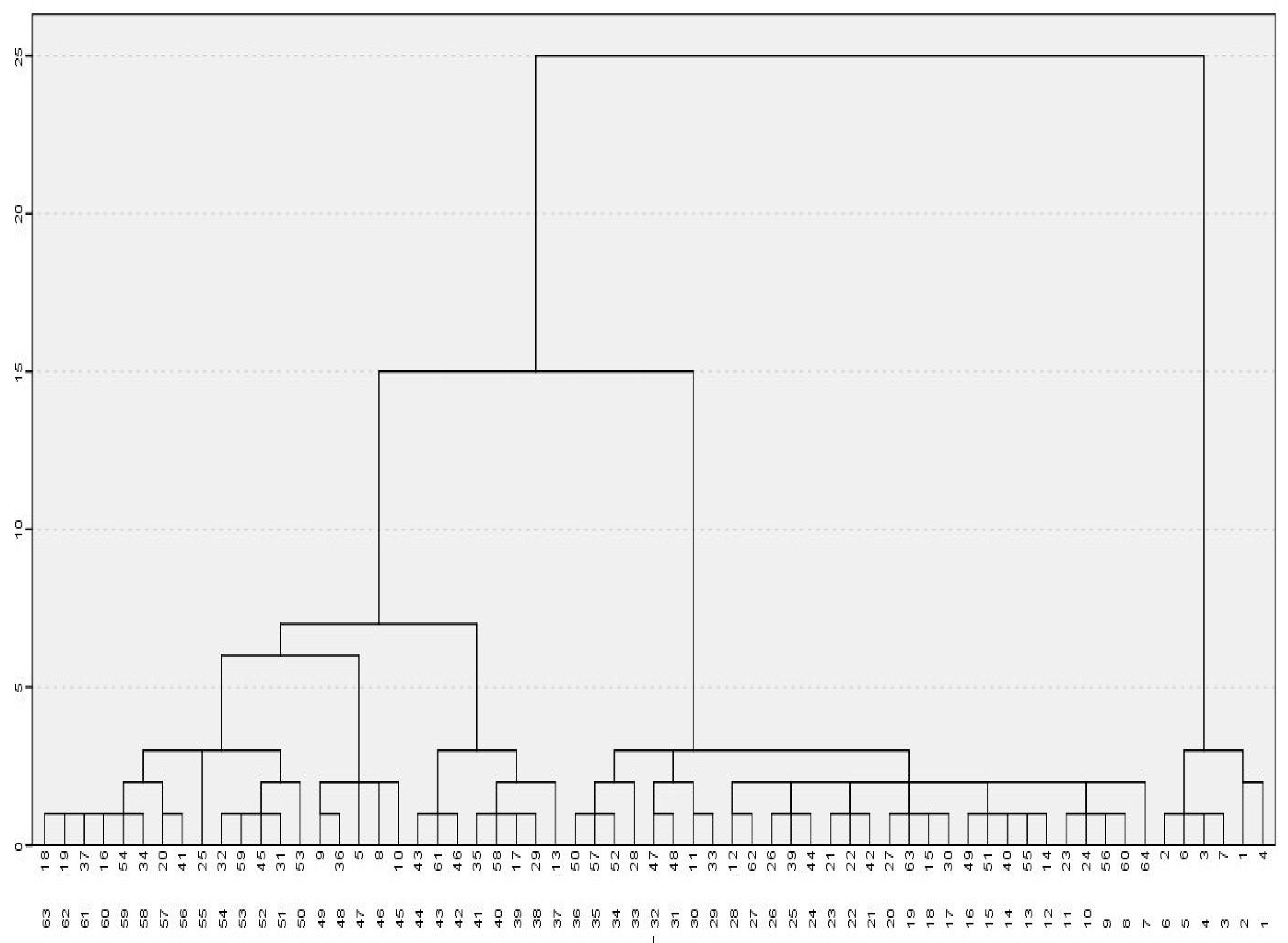
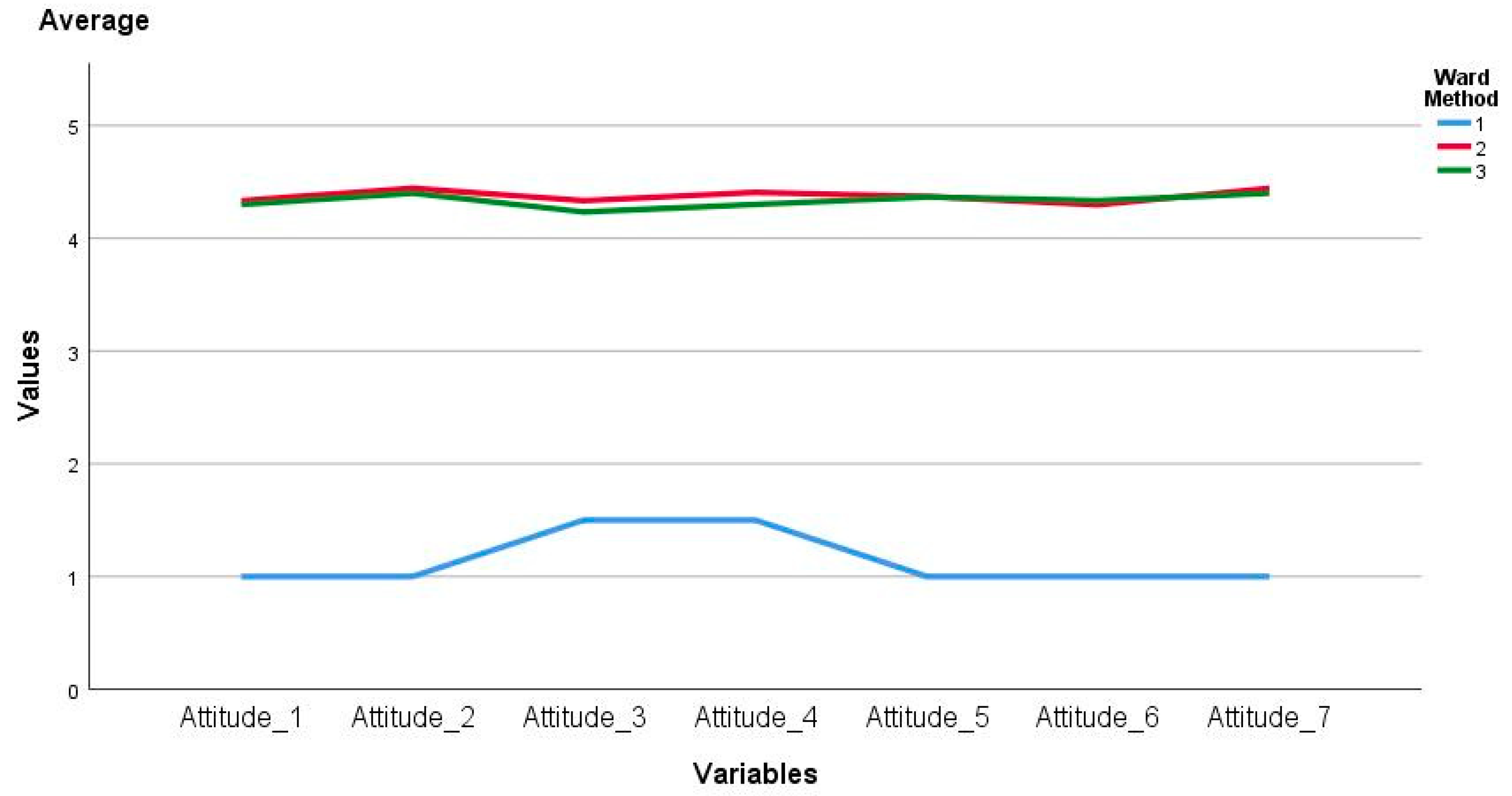

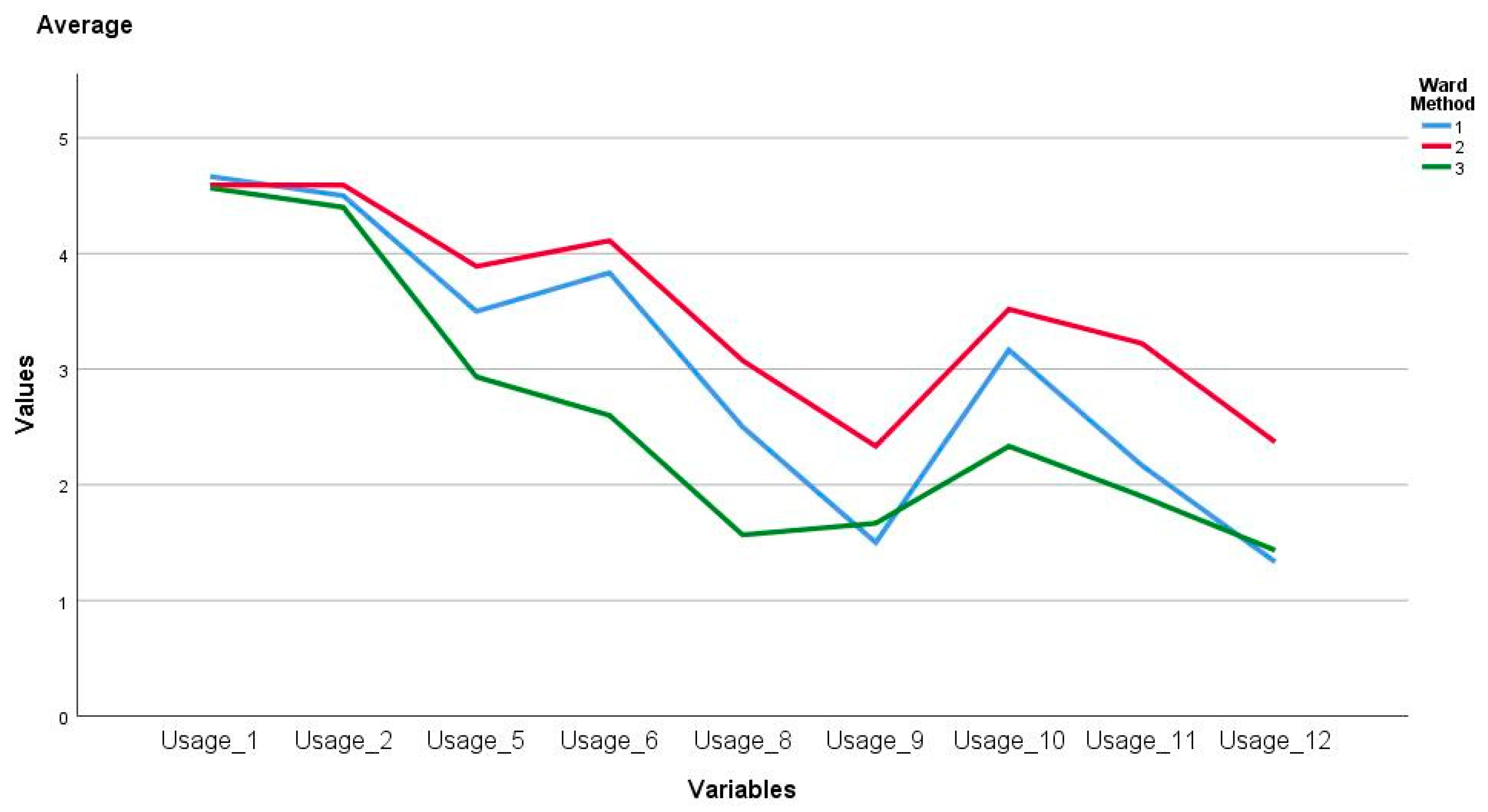

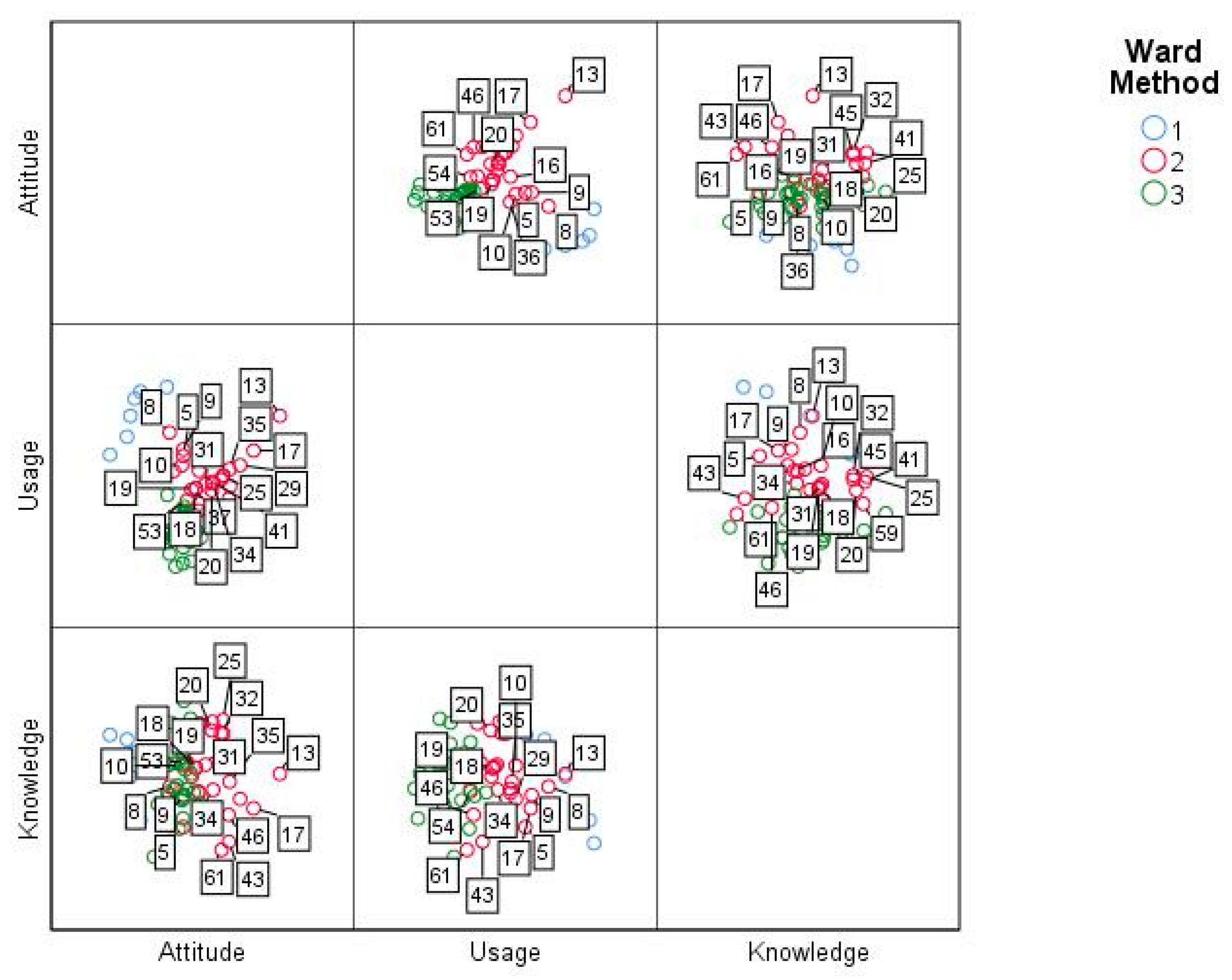
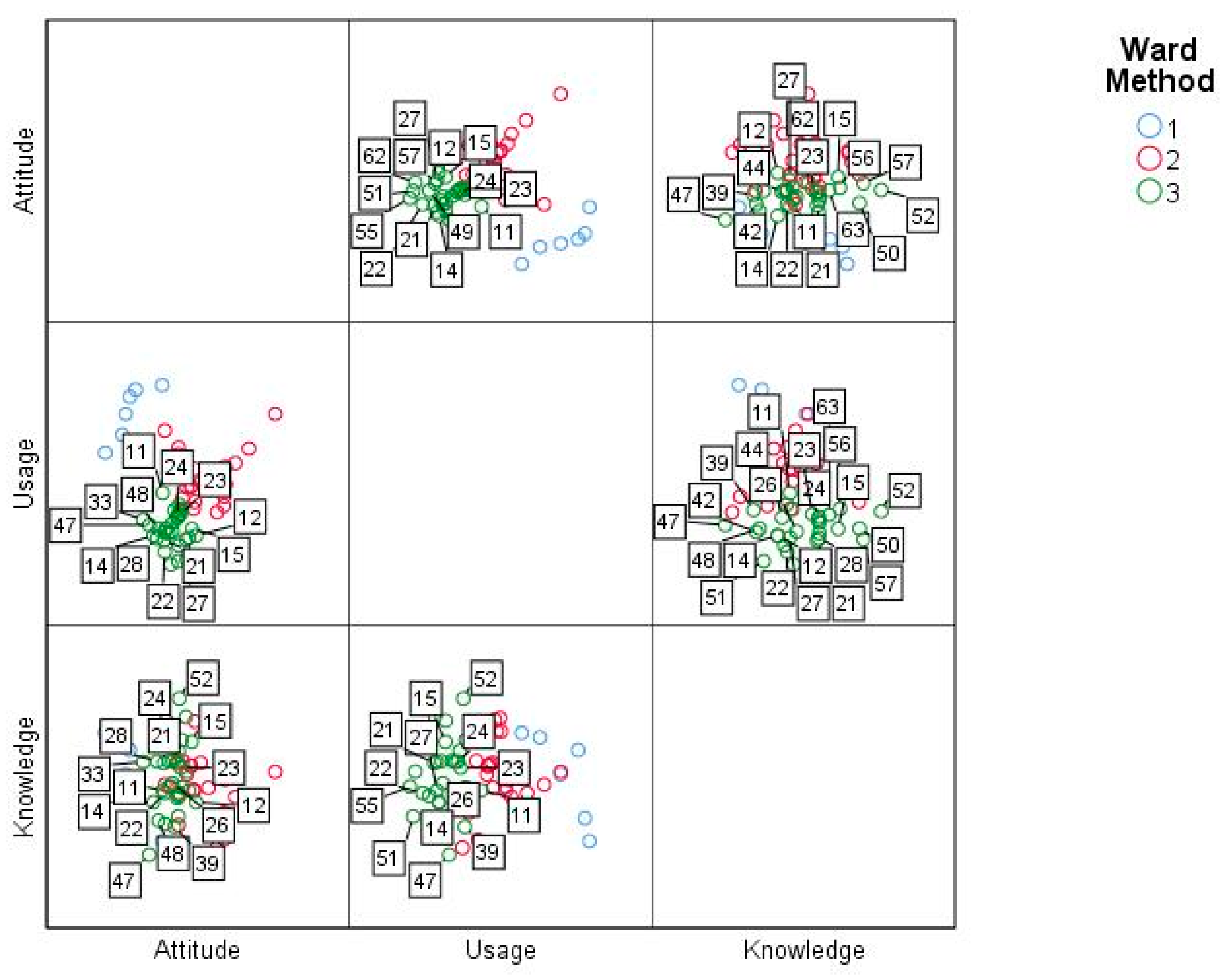
| Id | Item | 1 | 2 | 3 | 4 | 5 |
|---|---|---|---|---|---|---|
| Attitude_1 | ICT encourages involvement in the teaching and learning processes. | |||||
| Attitude_2 | Teachers must use ICT to improve the quality of learning processes. | |||||
| Attitude_3 | It is essential to incorporate ICT into university classrooms. | |||||
| Attitude_4 | Classes improve as ICTs are incorporated. | |||||
| Attitude_5 | ICT facilitates the development of classes. | |||||
| Attitude_6 | ICT enables the achievement of skills. | |||||
| Attitude_7 | ICT provides flexibility of space and time for communication between members of the educational community. |
| Id | Item | 1 | 2 | 3 | 4 | 5 |
|---|---|---|---|---|---|---|
| Con_1 | User tools and basic programs such as Word, Power Point, etc. | |||||
| Con_2 | Network information search tools such as Google, Yahoo!, Bing, Lycos, etc. | |||||
| Con_3 | Communication systems. For example, e-mail, forum, chat, videoconference, etc. | |||||
| Con_4 | Digital libraries and databases. | |||||
| Con_5 | 2.0 Tools. For example, YouTube, Slideshare, Picasa, Flickr, Blogger, Wikispaces, etc. | |||||
| Con_6 | Spaces for social interaction, such as Tuenti, Facebook, hi5, Pinterest, etc. | |||||
| Con_7 | Software for image, audio and video editing, such as Photoshop, Pixelmator, Audacity, Power Sound Editor, Windows Movie Maker, iMovie, etc. | |||||
| Con_8 | Virtual teaching-learning platforms, e.g., Sakai, Moodle, Suma, etc. | |||||
| Con_9 | Software for data analysis, such as SPSS, Mystat, Nud.ist, Atlas.ti, etc. | |||||
| Con_10 | Networked educational resources, such as translators, courses, podcast, repositories of learning objects, etc. | |||||
| Con_11 | Creation of virtual materials and networked resources for teaching and learning such as the e-portfolio, educational website, Wikis, video games, etc. | |||||
| Con_12 | Author’s educational software. Such as Clic, JClic, Hot Potatoes, NeoBook, etc. |
| Id | Item | 1 | 2 | 3 | 4 | 5 |
|---|---|---|---|---|---|---|
| Usage_1 | User tools and basic programs such as Word, Power Point, etc. | |||||
| Usage_2 | Network information search tools such as Google, Yahoo!, Bing, Lycos, etc. | |||||
| Usage_3 | Communication systems. For example, e-mail, forum, chat, videoconference, etc. | |||||
| Usage_4 | Digital libraries and databases. | |||||
| Usage_5 | 2.0 Tools. For example, Youtube, Slideshare, Picasa, Flickr, Blogger, Wikispaces, etc. | |||||
| Usage_6 | Spaces for social interaction, such as Tuenti, Facebook, hi5, Pintest, etc. | |||||
| Usage_7 | Software for image, audio and video editing, such as Photoshop, Pixelmator, Audacity, Power Sound Editor, Windows Movie Maker, iMovie, etc. | |||||
| Usage_8 | Virtual teaching-learning platforms, e.g., Sakai, Moodle, Suma, etc. | |||||
| Usage_9 | Software for data analysis, such as SPSS, Mystat, Nud.ist, Atlas.ti, etc. | |||||
| Usage_10 | Networked educational resources, such as translators, courses, podcast, repositories of learning objects, etc. | |||||
| Usage_11 | Creation of virtual materials and networked resources for teaching and learning such as the e-portfolio, educational website, Wikis, video games, etc. | |||||
| Usage_12 | Author’s educational software. Such as Clic, JClic, Hot Potatoes, NeoBook, etc. |
| Component | Initial Self-Values | Sums of Loads Squared from the Extraction | ||||
|---|---|---|---|---|---|---|
| Total | % Variation | % Accumulated | Total | % Variation | % Accumulated | |
| 1 | 6.87 | 26.42 | 26.42 | 6.87 | 26.42 | 26.42 |
| 2 | 4.90 | 18.86 | 45.29 | 4.90 | 18.86 | 45.29 |
| 3 | 2.99 | 11.50 | 56.80 | 2.99 | 11.50 | 56.80 |
| 4 | 1.68 | 6.49 | 63.29 | |||
| 5 | 1.30 | 5.03 | 68.32 | |||
| 6 | 1.12 | 4.32 | 72.64 | |||
| 7 | 0.99 | 3.84 | 76.48 | |||
| 8 | 0.78 | 3.02 | 79.51 | |||
| 9 | 0.74 | 2.84 | 82.35 | |||
| 10 | 0.58 | 2.26 | 84.62 | |||
| 11 | 0.54 | 2.09 | 86.71 | |||
| 12 | 0.49 | 1.91 | 88.63 | |||
| 13 | 0.46 | 1.77 | 90.41 | |||
| 14 | 0.38 | 1.47 | 91.88 | |||
| 15 | 0.36 | 1.38 | 93.26 | |||
| 16 | 0.31 | 1,20 | 94.47 | |||
| 17 | 0.26 | 1.01 | 95.48 | |||
| 18 | 0.24 | 0.93 | 96.42 | |||
| 19 | 0.19 | 0.75 | 97.17 | |||
| 20 | 0.18 | 0.71 | 97.89 | |||
| 21 | 0.13 | 0.52 | 98.41 | |||
| 22 | 0.11 | 0.44 | 98.85 | |||
| 23 | 0.10 | 0.41 | 99.26 | |||
| 24 | 0.08 | 0.30 | 99.57 | |||
| 25 | 0.06 | 0.24 | 99.81 | |||
| 26 | 0.04 | 0.18 | 100.00 | |||
Publisher’s Note: MDPI stays neutral with regard to jurisdictional claims in published maps and institutional affiliations. |
© 2021 by the authors. Licensee MDPI, Basel, Switzerland. This article is an open access article distributed under the terms and conditions of the Creative Commons Attribution (CC BY) license (http://creativecommons.org/licenses/by/4.0/).
Share and Cite
Martinez-Daza, M.A.; Guzmán Rincón, A.; Castaño Rico, J.A.; Segovia-García, N.; Montilla Buitrago, H.Y. Multivariate Analysis of Attitudes, Knowledge and Use of ICT in Students Involved in Virtual Research Seedbeds. Eur. J. Investig. Health Psychol. Educ. 2021, 11, 33-49. https://doi.org/10.3390/ejihpe11010004
Martinez-Daza MA, Guzmán Rincón A, Castaño Rico JA, Segovia-García N, Montilla Buitrago HY. Multivariate Analysis of Attitudes, Knowledge and Use of ICT in Students Involved in Virtual Research Seedbeds. European Journal of Investigation in Health, Psychology and Education. 2021; 11(1):33-49. https://doi.org/10.3390/ejihpe11010004
Chicago/Turabian StyleMartinez-Daza, Magda Alejandra, Alfredo Guzmán Rincón, Jader Alexis Castaño Rico, Nuria Segovia-García, and Harvey Yesid Montilla Buitrago. 2021. "Multivariate Analysis of Attitudes, Knowledge and Use of ICT in Students Involved in Virtual Research Seedbeds" European Journal of Investigation in Health, Psychology and Education 11, no. 1: 33-49. https://doi.org/10.3390/ejihpe11010004
APA StyleMartinez-Daza, M. A., Guzmán Rincón, A., Castaño Rico, J. A., Segovia-García, N., & Montilla Buitrago, H. Y. (2021). Multivariate Analysis of Attitudes, Knowledge and Use of ICT in Students Involved in Virtual Research Seedbeds. European Journal of Investigation in Health, Psychology and Education, 11(1), 33-49. https://doi.org/10.3390/ejihpe11010004





